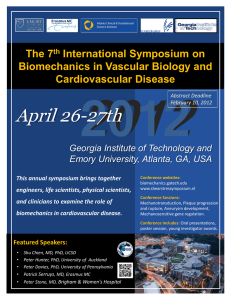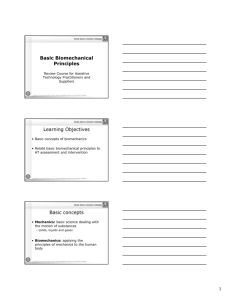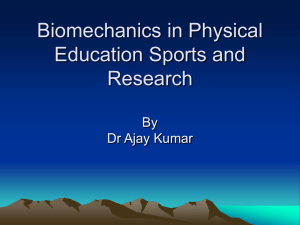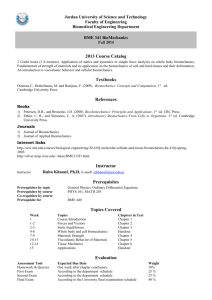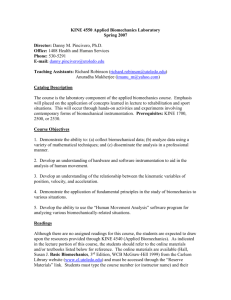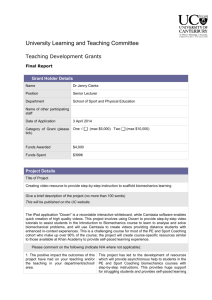Yeadon, M.R. 2005. What are the limitations of experimental and
advertisement
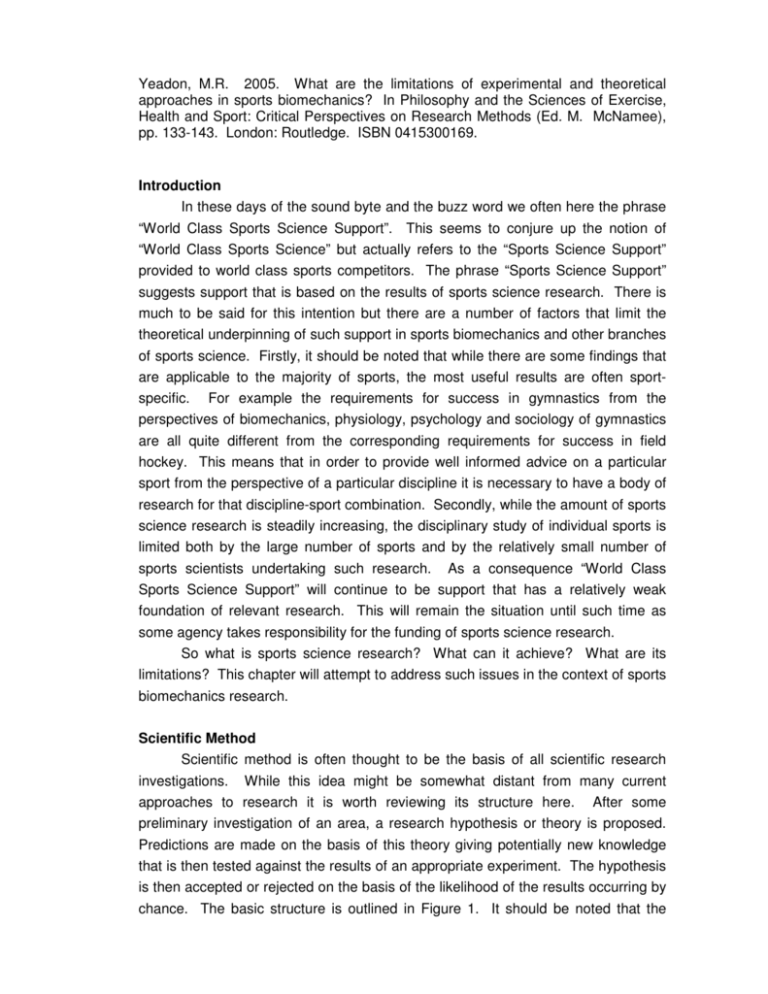
Yeadon, M.R. 2005. What are the limitations of experimental and theoretical approaches in sports biomechanics? In Philosophy and the Sciences of Exercise, Health and Sport: Critical Perspectives on Research Methods (Ed. M. McNamee), pp. 133-143. London: Routledge. ISBN 0415300169. Introduction In these days of the sound byte and the buzz word we often here the phrase “World Class Sports Science Support”. This seems to conjure up the notion of “World Class Sports Science” but actually refers to the “Sports Science Support” provided to world class sports competitors. The phrase “Sports Science Support” suggests support that is based on the results of sports science research. There is much to be said for this intention but there are a number of factors that limit the theoretical underpinning of such support in sports biomechanics and other branches of sports science. Firstly, it should be noted that while there are some findings that are applicable to the majority of sports, the most useful results are often sportspecific. For example the requirements for success in gymnastics from the perspectives of biomechanics, physiology, psychology and sociology of gymnastics are all quite different from the corresponding requirements for success in field hockey. This means that in order to provide well informed advice on a particular sport from the perspective of a particular discipline it is necessary to have a body of research for that discipline-sport combination. Secondly, while the amount of sports science research is steadily increasing, the disciplinary study of individual sports is limited both by the large number of sports and by the relatively small number of sports scientists undertaking such research. As a consequence “World Class Sports Science Support” will continue to be support that has a relatively weak foundation of relevant research. This will remain the situation until such time as some agency takes responsibility for the funding of sports science research. So what is sports science research? What can it achieve? What are its limitations? This chapter will attempt to address such issues in the context of sports biomechanics research. Scientific Method Scientific method is often thought to be the basis of all scientific research investigations. While this idea might be somewhat distant from many current approaches to research it is worth reviewing its structure here. After some preliminary investigation of an area, a research hypothesis or theory is proposed. Predictions are made on the basis of this theory giving potentially new knowledge that is then tested against the results of an appropriate experiment. The hypothesis is then accepted or rejected on the basis of the likelihood of the results occurring by chance. The basic structure is outlined in Figure 1. It should be noted that the 2 above description is that of “Experimental Method” rather than “Scientific Method”. In Exercise Physiology, for example, so much of the research is experimentally based that a student might assume that “Science is Experimental Science” but this neglects an important aspect of scientific investigation, namely “Theoretical Science”. initial investigation hypothesis experiment prediction conclusion Figure 1. The structure of Scientific Method. The idea of “Theoretical Method” may be thought to have the same basic structure as “Experimental Method” (Figure 1). Instead of employing a concise hypothesis with readily obtainable implications, an underlying theory is proposed that may lead to conclusions only after much development and analysis. An example of a hypothesis is that “more training will result in better performance” whereas Einstein’s Theory of General Relativity is an example of a theory that cannot be defined completely using a single phrase. The first example might lead us to expect that if running 100 miles each week enhances performance then running 200 miles per week will result in even better performance while the second example makes possible the accurate location of an athlete using the Global Positioning System. The way in which the comparison is made between experimental and theoretical results is also different in the theoretical approach. While experimental science makes a judgement using the likelihood of the experimental results arising by chance, theoretical science makes a judgement on the basis of how accurate the prediction is and how much hitherto unexplained phenomena can be accounted for. For example an experiment on the relationship between the amount of training and subsequent performance may involve an 3 experimental group and a control group and will assess the difference in performance of the two groups using statistical tests. On the other hand Einstein’s General Theory of Relativity predicted that the Sun would bend light from a distant star through 1.74 seconds of arc (0.0005o) rather than half this amount as predicted by Newtonian mechanics. Measurements taken during an eclipse of the Sun gave estimated deviations of 1.61 and 1.98 seconds and supported the adoption of the model of Einstein rather than that of Newton. The general acceptance of this theory is based on its ability to explain many other results that cannot be accounted for by Newtonian mechanics. The types of question that can be addressed by experimental and theoretical approaches also differ as do the challenges posed by each method. These issues will be considered with reference to experimental and theoretical studies in biomechanics. Experimental Studies Typically an experiment attempts to test causal relationships between variables – for example, the relationship between approach speed and distance jumped. In an ideal experiment the effect of changing just one variable (approach speed), the independent variable, on the outcome (distance jumped), the dependent variable, is determined. If it were possible to change only one variable then changes in the outcome would have to be a consequence of changes in this independent variable. Although it may be possible to design such ideal experiments in certain branches of the natural sciences, the complexity of the human system prevents prevents such tight control within the sports sciences. In sports biomechanics attempts to change just one aspect of technique in the sports performance of an individual will inevitably result in other changes and this will require a large number of trials in order to isolate the effects of each variable. Another feature of a well-designed experiment is that the conclusions will be applicable to the real world. The tighter the control of an experiment to remove unwanted variance, the more likely that the experiment will differ from a natural setting. In other words, the stronger the internal validity, the weaker the external validity. Obtaining data from performances in a natural setting such as competition may yield only a small number of attempts on a single day. Using intervention to manipulate technique in other settings may itself render the performance untypical due to the “Hawthorne effect” whereby the mere knowledge of participation in an experiment may affect the outcome (Rothstein, 1985). Such intervention may not be possible due to concerns of the athlete and coach or allied ethical concerns. For example, there may be issues of potential injury or disruption of learned technique arising from experimental interventions. Despite such problems it may be still 4 possible to obtain clear results from an experiment with an athlete. For example, Greig and Yeadon (2000) used data on 16 high jumping trials from a training session of one athlete to establish quadratic relationships between approach speed and height jumped and between leg plant angle and height jumped. Because of the difficulties in obtaining sufficient data on a single athlete, some researchers use combined data from several athletes. Hay (1987) cautions against statistical analyses in which several jumps by each of a number of athletes are treated as if they were single trials performed by different athletes, since trials by the same athlete cannot be regarded as independent trials. A more appropriate approach would be to use a repeated measures design. Additionally it should be recognised that the relationships between variables may be very different when the best performances of a number of athletes are taken rather than a number of performances from a single athlete. The relationship between height reached and approach speed in high jumping is quadratic for an individual (Alexander, 1990) so that there is an optimum approach speed for which the height jumped is greatest. On the other hand, the relationship is linear for a group of athletes (Dapena et al., 1990) so that the height jumped increases with the approach speed. In other words while there is an optimum approach speed for an individual, the better jumpers are stronger, faster and jump higher. Confusion in this area can lead to relationships that are unrelated to individual performance. distance [m] 0 5 10 -1 velocity [ms ] Figure 2. A hypothetical data set showing approach speed and distance jumped for long jumping. Even when data are collected on an individual athlete in a natural setting such as competition the search for relationships between variables is likely to be frustrated since performances have been optimised. In long jumping it is accepted that approach speed is strongly related to distance jumped. In competition, 5 however, all performances are likely to be close to optimum. This results not only in a small range of variable values but also in a flat response. Near an optimum a performance variable such as distance jumped will be quadratically related to a variable such as approach speed so that the theoretical graph will resemble an inverted U (Figure 2). Around the optimum, therefore, data will exhibit a flat linear trend rather than an inclined linear response. As a consequence linear regression analysis will yield no relationship. On the other hand quadratic regression analysis will also yield little due to the small amount and range of data. Failure to recognise such effects will result in abortive attempts to reveal underlying relationships. Linear regression is sometimes used in a fishing expedition to find relationships between variables by investigating every pair of variables. This “shotgun” approach has the drawback that it may identify “significant” relationships when, in reality, no such relationships exist. For example, if the level of significance is set at 5% and all 45 pairs from 10 variables are regressed in turn, it may be expected that two “significant” regressions will occur by chance. If there are three significant regressions in such a study then it may be that there is a real relationship between a pair of variables but which pair of the three will not be known. Extreme examples of this type report the expected number of random correlations as significant (Williams et al., 1988). Hay and Reid (1982) proposed a hierarchical deterministic structure for identifying potential causal relationships prior to performing regressions of one variable against another. While this procedure is certainly an improvement upon regressing each variable against all others, implementations include a number of the weaknesses described above. Firstly, the deterministic model is implicitly based on the performance of a single athlete whereas implementations of the method typically use data from several athletes. Secondly, linear regression is typically used without thought, even in cases where the theoretical relationship between variables is known to be non-linear. The reason for this is over-reliance on computer packages without an understanding of what they provide and the consequence is failure to find a relationship when one exists. Finally the search for relationships around an optimum will usually be unrewarding since the response if flat and the range of data usually too small to reveal curvature as described earlier. The aim of research is to bring understanding to an area of study by way of providing explanations. Such explanations should do more than establish relationships between variables – they should explain how and why these relationships arise. The benefit of using an arm swing when jumping for height may be explained by showing that the arm swing puts the leg extensors in slower concentric conditions and so greater force can be exerted (Hill, 1938). To demonstrate that this is so is not possible using a kinetic analysis of jumps with and 6 without arm swing. It may be possible to demonstrate experimentally that jumps with arm swing allow greater leg extensor force to occur and that greater jump height occurs. To demonstrate that the leg extensors are in slower concentric conditions as a consequence of the arm swing requires the use of a theoretical model (Dapena, 1999). As a consequence studies aiming to reveal mechanisms using experimental studies of whole body movement either speculate on the mechanisms (Lees et al., 1994) or conclude that the mechanisms are unclear (Feltner et al., 1999). Interpretation of experimental results is often a function of how the world is viewed. The leap from an experimental result that more training results in better performance to a general conclusion to this effect arises from an (unstated) belief that response is linear when in general it is not. Komi and Mero (1985) express surprise that the increase in javelin range is disproportionately larger that the increase in release velocity. This error arises from an implicitly linear view of the world. As Hubbard (1989) wryly observes, a basic theoretical understanding that range is a quadratic function of velocity would lead to the opposite conclusion. In a final note on experimental studies, it should be noted that human response to a changed situation may be individual and somewhat unpredictable. For example, the responses to changes in surface cushioning when running can be highly individual (Dixon et al., 2000) and the effects of shoe inserts on gait can be unpredictable (Nigg et al., 1998). Additionally the assessment of cushioning materials for running can give quite different results when subject tests are used rather than material tests ( Kaelin et al. 1985). In an experiment in which weights were attached to a runner, the maximum vertical force recorded by a force plate, rather than increasing with increased weight, did not change (Bahlsen and Nigg, 1987). This was a consequence of the runners modifying their technique, presumably to achieve a similar pressure sensation on the foot. Adaptations of technique such as these can complicate what may appear to be a simple intervention. Theoretical Studies As noted in the above section, experimental studies have inherent problems arising from real-world effects such as the limitations of humans in making ideal changes to technique. In this section the advantages of using a theoretical model will be discussed along with the inherent difficulties of such an approach. A model is a representation of a real-world system such as a human body. Such a representation is necessarily a simplification since a model that is accurate in all respects in representing a human body will be indistinguishable from a human body. Since a model cannot reproduce all aspects of the real system it is first 7 necessary to identify which elements of the real system should be included and how they should be represented. This is not a straightforward task as there is no guarantee that a carefully constructed model will perform in the required manner. A typical model in sports biomechanics might comprise a number of body segments connected by simple pin joints together with some mechanism for exerting torque about each joint (e.g. Hatze, 1981). Often a process of iteration is necessary in which modifications are made until the model is able to match an actual performance. For example wobbling masses may be included within the model to represent soft tissue movement within the segments (Gruber et al., 1998). Without such wobbling masses the forces calculated by a model may overestimate the actual forces in a movement. In order to assess when modifications result in an adequate model, a quantitative method of model evaluation is required. Typically data obtained from a real performance will be used as input to the model and the model output will be compared with the corresponding values from the actual performance. The cycle of model improvement is shown in Figure 3. experimental input new model experimental outcome modify model model output assess comparison Figure 3. The cycle of model evaluation and model modification. 8 This step of model evaluation is essential before attempting to use the model to address research questions. Failure to do so will render any results uncertain and may lead to insights peculiar to the model rather than the real world and this will lead to misunderstanding rather than to understanding. Panjabi (1979) cautioned against evaluating a model in one situation and then using the model in a quite different situation. He also observed that most model models in biomechanics are not evaluated and, sadly, this still remains the case today (Gerritsen et al., 1995; Pandy et al., 1990; van Soest, A.J. et al., 1993; Spagele et al., 1999; Sprigings, 1998). While a number of models demonstrate some general agreement with experimental results (Alexander, 1990), very few determine subject-specific model parameters (King and Yeadon, 2002) and then assess the ouput of the model in a quantitative manner by comparison with individual performances (Yeadon and King, 2002). The term “validation” rather than “evaluation” of models is often used. While evaluation may be relatively well-defined in terms of measuring the difference between experimental and simulated results, validation is often used to mean that the model reflects the way the world “really is”. As Oreskes et al. (1994, p. 642) comment “the establishment that a model represents the ‘actual processes occurring in a real system’ is not even a theoretical possibility”. They also observe (p. 644) “models are most useful when they are used to challenge existing formulations, rather to validate or verify them”. Bearing in mind these inherent limitations, the ways in which models may be used will now be considered. Applications of Models In an ideal experiment to establish causality just one element of the system is changed to determine its effect. As noted earlier, in practical experiments with athletes this is far from possible. With a theoretical model, on the other hand, it is achievable. It is important, however, that changes to a variable are realistic and are based on experimental data. Such an approach makes it possible to answer “What if?” questions and is able to address “Why?” things occur without much recourse to the speculation that is inherent in experimental studies. Additionally a theoretical approach comes much closer to establishing causality than experimental studies that are limited to the demonstration of high correlations. Perhaps the most powerful way of using a simulation model is in optimisation studies. Since a simulation model can generate a performance in a second or less it is possible to test the outcome of thousands of scenarios and come to some conclusion on the technique that will produce a performance that is optimal in some sense. For example, in high jumping the optimisation criterion might be the peak height of the mass centre in flight. Because of the automatic nature of the search 9 for optimal technique there are potential problems. Even with sophisticated optimisation programs such as Simulated Annealing (Goffe et al., 1994) there is no guarantee that the global optimum will be found. The search for an optimum can be likened to the search for the highest mountain peak in a given terrain. An optimisation routine may find a local rather than a global optimum. In other words the software may find the top of a foothill rather than the summit of the highest mountain. On the other hand the routine may be successful in finding the top of a singular pinnacle that stands on a narrow base high above the surrounding terrain. Even if this is the global optimum it is a summit that should not be attempted since any small location error will land on low terrain. In other words if there is an optimum technique in javelin that is surrounded by poor performances, it is a poor strategy that strives for this in the distant hope that everything will come right on one of the attempts. The likelihood is that all performances will be poor. A better strategy may be to find a high hilltop with a large plateau so that points even some distance away are high. There is much to be said for consistency when competing. Attempts to identify an optimisation criterion that is responsible for the adoption of a particular strategy can suffer from a failure to consider the context holistically. If the research focus is lead by information from descriptive studies then little insight may be gained. For example in trying to explain why a smooth movement strategy is adopted for tasks such as drawing a line between two points, a demonstration that minimising the rate of change of acceleration results in similar strategies (Hogan, 1984) does little to bring understanding to the subject. In contrast a strategy minimising the error in targeting leads to an explanation of Fitt’s Law on the trade-off between accuracy and speed in targeted movements (Harris and Wolpert, 1998) giving real insight into movement strategy. In a similar vein van Soest (1994) showed that optimum strategy in vertical jumping is dependent upon initial position but there exists a strategy that is close to optimal for a wide range of starting positions, suggesting that an element of robustness to change may be included in optimisation strategies adopted by humans. In other words it is likely that human movement strategies are best in the sense that small perturbations do not cause a large degradation in performance. Following this idea Hiley and Yeadon (2003) identified the margin for error for timing release as an important determinant of high bar circling technique in Men’s Artistic Gymnastics. Attempts to assess sensitivity of human performance using a theoretical model are likely to overestimate the sensitivity since if this is a critical element in the performance, the athlete (as opposed to the model) will adopt strategies to reduce the sensitivity. While a theoretical model can attempt to replicate such strategies it will do so in a way that is a simplified representation of the real system and will have less flexibility 10 in the search for robustness of performance in response to perturbations in the timing of muscle contractions, for example. Postscript While the case for a particular conclusion may appear clear it should be remembered that research is conducted by humans and that humans are fallible. This is true for the natural sciences no less than for the social sciences. For example in astronomy telescopic observations of Mercury taken at different times showed the same face of Mercury facing the sun and it was concluded that the planet rotated once about its own axis for one revolution about the sun. Since this result was consistent with the theoretical expectation of gravitational lock it was generally accepted as conclusive. The observations, however, were taken at intervals of six months during which Mercury had completed two orbits of the sun (Dyce et al., 1967). Subsequently it was discovered from radar measurements that Mercury rotates three times about its own axis for every two orbits of the sun. As a consequence after an interval of six months Mercury was again in the same orientation. From a theoretical perspective a 3:2 ratio is understandable as well as a 1:1 ratio as in the case of the moon orbiting the Earth. Thus a myopic interpretation of both experimental and theoretical data lead to a false conclusion that was generally accepted from 1882 until 1965. Our conceptual frameworks constrain the kind of questions that can be formulated and the kind of answers that are considered. The search for a single mathematical optimisation criterion to explain the strategy adopted by the central nervous system to achieve a specific task will give way to somewhat different considerations when it is appreciated that robustness of response to perturbations is necessary. The idea that offspring must exhibit an intermediate blend of parental characteristics persisted in the nineteenth century due to the idea that the world was smooth and continuous rather than discrete and digital. Against this mainstream Darwin noted that offspring were distinctly male or female rather than of intermediate sex (Dawkins, 2003). The problems arising from the duality of mind and body disappear once it is accepted that there is no duality. The problem of consciousness is likely to recede once the remnants of the dichotomy between man and beast are finally laid to rest. The idea that we have no free will since ideas originate in the subconscious before reaching the conscious mind will also dissipate when it is discovered that the conscious also affects the subconscious and that a personality properly includes both. Finally the idea that “all truth must be one” may disappear once it is accepted that the “true” answer depends upon our conceptual framework in posing the question. 11 While humanity will continue to try to make sense out of what appears to be the universe there will always be the inherent limitation that Science is constrained to sit in Plato’s cave and attempt to interpret the flickering shadows on the cave wall. 12 References Alexander, R.M. 1990. Optimum take-off techniques for high and long jumps. Philosophical Transactions of the Royal Society, B239, 3-10. Bahlsen, H.A. and Nigg, B.M. 1987. Estimation of impact forces using the idea of an effective mass. In Biomechanics X-B (Ed. B. Jonsson), pp. 837-841. Champaign: Human Kinetics. Dapena, J. 1999. A biomechanical explanation of the effect of arm actions on the vertical velocity of a standing vertical jump. In Abstracts of the XVIIth International Society of Biomechanics Congress (Ed. W. Herzog and A. Jinha), p. 100. Calgary. Dapena, J., McDonald, C. and Cappaert, J. 1990. A regression analysis of high jumping technique. International Journal of Sport Biomechanics 6, 246-261. Dawkins, R. 2003. A Devil’s Chaplain: Selected Essays. London: Weidenfeld & Nicholson. Dixon, S.J., Collop, A.C. and Batt, M.E. 2000. The influence of surface shock absorption on ground reaction forces and kinematics in running. Medicine and Science in Sports and Exercise 32, 1919-1926. Dyce, R.B., Pettengill, G.H. and Shapiro, I.I. 1967. Radar determinations of the rotations of Venus and Mercury. Astronomical Journal 72, 351-359. Feltner, M.E., Fraschetti, D.J. and Crisp, R.J. 1999. Upper extremity augmentation of lower extremity kinetics during countermovement vertical jumps. Journal of Sports Sciences 17, 449-466. Gerritsen, K.G.M., van den Bogert, A.J. and Nigg, B.M. 1995. Direct dynamics simulation of the impact phase in heel-toe running. Journal of Biomechanics 28, 661-668. Goffe, W.L., Ferrier, G.D. and Rogers, J. 1994. Global optimisation of statistical functions with simulated annealing. Journal of Econometrics 60, 65-99. Greig, M.P. and Yeadon, M.R. 2000. The influence of touchdown parameters on the performance of a high jumper. Journal of Applied Biomechanics 16, 367378. Gruber, K., Ruder, H., Denoth, J., and Schneider, K. 1998. A comparative study of impact dynamics: wobbling mass model versus rigid body model. Journal of Biomechanics 31, 439-444. Harris, C.M. and Wolpert, D.M. 1998. Signal-dependent noise determines motor planning. Nature 394, 780-784. Hatze, H. 1981. A comprehensive model for human motion simulation and its application to the take-off phase of the long jump. Journal of Biomechanics 14, 135-142. 13 Hay, J.G. 1987. Biomechanics of the long jump – and some wider implications. In Biomechanics X-B (Ed. B. Jonsson). Champaign: Human Kinetics. Hay, J.G. and Reid, J.G. 1982. The Anatomical and Mechanical Bases of Human Movement. Englewood Cliffs, NJ: Prentice-Hall. Hiley, M.J. and Yeadon, M.R. 2003. The margin for error when releasing the high bar for dismounts. Journal of Biomechanics 36, 313-319. Hill, A.V. 1938. The heat of shortening and the dynamic constraints of muscle. Proceedings of the Royal Society of London, Series B 126, 136-195. Hogan, N. 1984. An organizing principle for a class of voluntary movements. Journal of Neuroscience 4, 2745-2754. Hubbard, M. 1989. The throwing events in track and field. In Biomechanics of Sport (Ed. K. Vaughan). Boca Rotan, FL: CRC Press. Kaelin, X., Denoth, J., Stacoff, A. and Stuessi, E. 1985. Cushioning during running - material tests versus subject tests. In Biomechanics: Principles and Applications (Ed. S.Perren), pp. 651-656. London: Martinus Nijhoff Publishers. King, M.A. and Yeadon, M.R. 2002. Determining subject specific torque parameters for use in a torque driven simulation model of dynamic jumping. Journal of Applied Biomechanics 18, 207-217. Komi, P.V. and Mero, A. (1985) Biomechanical analysis of Olympic javelin throwers. International Journal of Sport Biomechanics 1, 139-150. Lees, A., Graham-Smith, P. and Fowler, N. 1994. A biomechanical analysis of the last stride, touchdown, and takeoff characteristics of the Men’s long jump. Journal of Applied Biomechanics 10, 61-78. Nigg, B.M., Khan, A., Fisher, V. and Stefanyshyn, D. 1998. Effects of shoe insert construction on foot and leg movement. Medicine and Science in Sports and Exercise 30, 550-555. Oreskes, N., Shrader-Frechette, K. and Belitz, K. 1994. Verification, validation and confirmation of numerical models in the earth sciences. Science 263, 641-646. Pandy, M.G., Zajac, F.E., Sim, E. and Levine, W.S. 1990. An optimal control model for maximum-height human jumping. Journal of Biomechanics 23, 1185-1198. Panjabi, M. 1979. Validation of mathematical models. Journal of Biomechanics 12, 238. Rothstein, A.L. 1985. Research Design and Statistics for Physical Education. Englewood Cliffs, NJ: Prentice-Hall. Soest, A.J. van, Schwab, A.L., Bobbert, M.F. and van Ingen Schenau, G.J. 1993. The influence of the biarticularity of the gastrocnemius muscle on verticaljumping achievement. Journal of Biomechanics 26, 1-8. 14 Soest, A.J. van. 1994. Control strategies in vertical jumping and implications for training. In Proceedings: Second World Congress on Biomechanics, 132. Amsterdam: Stichting World Biomechanics. Spagele, T., Kistner, A. and Gollhofer, A. 1999. Modelling, simulation and optimisation of a human vertical jump. Journal of Biomechanics 32, 521-530. Sprigings, E.J., Lanovaz, J.L., Watson, L.G. and Russell, K.W. 1998. Removing swing from a handstand on rings using a properly timed backward giant circle: a simulation solution. Journal of Biomechanics 31, 27-35. Williams, K.R., Snow, R. and Agruss, C. 1988. Changes indistance running kinematics with Fatigue. Medicine and Science in Sports and Exercise 20, S49. Yeadon, M.R. and King, M.A. 2002. Evaluation of a torque driven simulation model of tumbling. Journal of Applied Biomechanics 18, 195-206.

